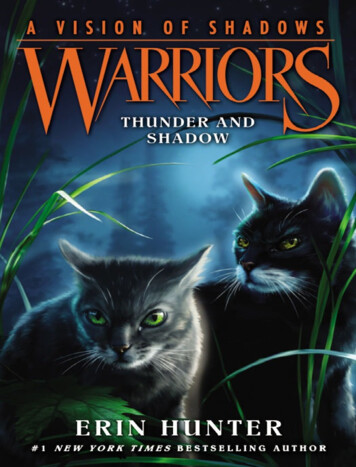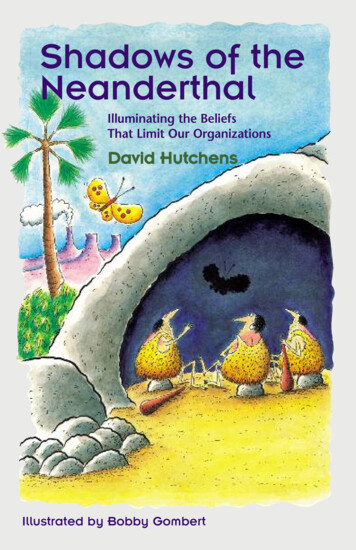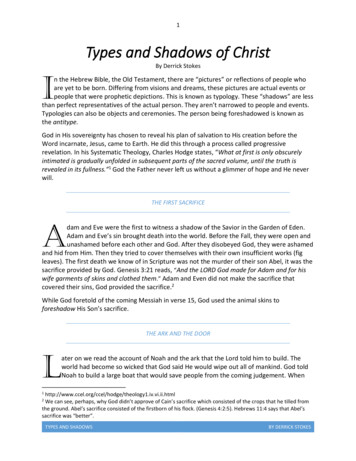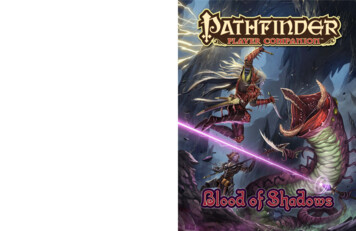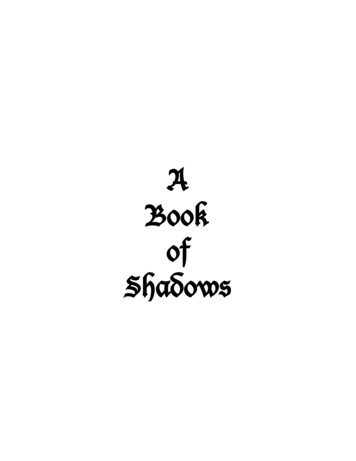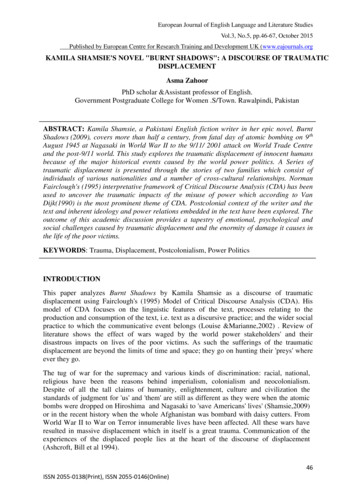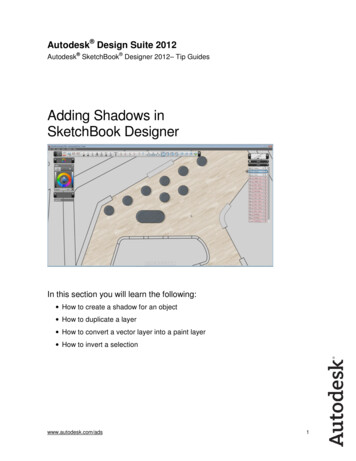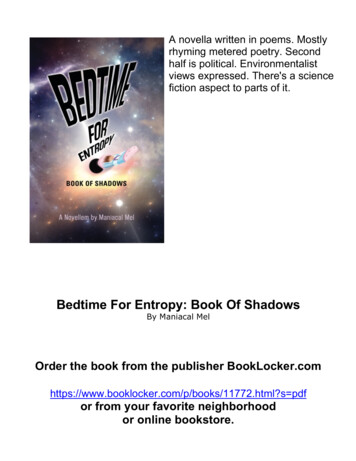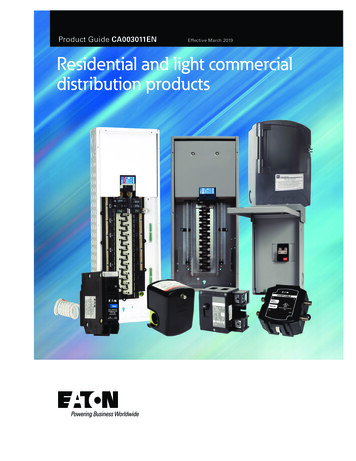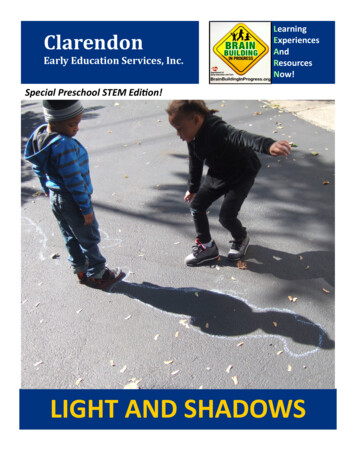
Transcription
ClarendonEarly Education Services, Inc.LearningExperiencesAndResourcesNow!Special Preschool STEM Edition!LIGHT AND SHADOWS
Welcome!DOCUMENTINGCHILDREN’S EXPLORATIONSGreetings! Clarendon is very pleased to presentanother special Preschool STEM edition of LEARN.This project is made possible through generousgrant funding from the MassachusettsDepartment of Early Education and Care.This month we focus on Light and Shadows, withideas for children’s explorations indoors andoutdoors, using both natural and man-madesources of light. We hope that you will use someof these projects over time, developing moreideas based on the children’s interests. Try toextend children’s learning about light andshadows during routine times of day, like mealpreparation or waiting for the bus. Do you seeany shadows in the kitchen? Where is the lightcoming from? Do you think the shadows will lookthe same tomorrow? Where do you see light atnight?Please note that more wonderful activities can befound in the Guidelines for Preschool LearningExperiences, as well as in the Resources section ofthis guide. Remember that your daily interactionswith your children and families not only helpchildren to develop positive self-concepts, butalso support new skills in science, technology,engineering and math! Please encourage theirnatural curiosity about light and shadow, andenjoy their enthusiasm.Young children learn best when caring adults showinterest in their efforts. Documenting children’sprojects provides opportunities to extend theirlearning, and provides information for you to assesstheir progress. What did you do? How did it work?What else could you try? What might happen if ?The work of Lillian Katz (please see Resources)expresses the importance of documentingchildren’s work. The following are a few simpleways to include documentation in your dailypractice: Provide paper and pencils, crayons or markersfor children to draw pictures of theirobservations or projects. Clip boards orhardcover books with clips can be used outside. Encourage children to write or dictate theirdescriptions of observations or investigations. Use your phone, camera or I-Pad to take photosor videos of children’s work. Encourage children to create books about theirprojects using either drawings or photos. Create displays of projects using drawings,photos and writing to revisit them with thechildren and share with families. Invite families to view videos of their children’swork. Have a Light and Shadows celebration!The U.S. Department of Agriculture prohibits discrimination against its customers, employees, andapplicants for employment on the bases of race, color, national origin, age, disability, sex, genderidentity, religion, reprisal, and where applicable, political beliefs, marital status, familial or parentalstatus, sexual orientation, or all or part of an individual's income is derived from any public assistanceprogram, or protected genetic information in employment or in any program or activity conducted orfunded by the Department. (Not all prohibited bases will apply to all programs and/or employmentactivities.)If you wish to file a Civil Rights program complaint of discrimination, complete the USDA ProgramDiscrimination Complaint Form, found online at http://www.ascr.usda.gov/complaint filing cust.html,or at any USDA office, or call (866) 632-9992 to request the form. You may also write a letter containingall of the information requested in the form. Send your completed complaint form or letter to us by mailat U.S. Department of Agriculture, Director, Office of Adjudication, 1400 Independence Avenue, S.W.,Washington, D.C. 20250-9410, by fax (202) 690-7442 or email at program.intake@usda.gov.Individuals who are deaf, hard of hearing or have speech disabilities may contact USDA through theFederal Relay Service at (800) 877-8339; or (800) 845-6136 (Spanish).USDA is an equal opportunity provider and employer.2Any recipes included are not intended for CACFP use. No CACFP funds were used in the development of this document.
LEARNING EXPERIENCES AND INVESTIGATIONSOUR PHILOSOPHYChildren learn through positive interactions with caring adults who understand howchildren develop and provide opportunities for meaningful hands-on learningexperiences. They learn best through engaging their senses and need individual supportas they explore and discover themselves, others and the world around them in thecontext of their families and cultures.ARTShadow PaintingBLOCKSLight It Up!Materials: Black or bluepaint and brushes, whitepaper, desk lamp, varietyof objectsProcedure: Darken the room and use a desk ortable lamp on a table to show children how theycan make shadows on paper with objects. Askchildren to choose objects (plastic animals,kitchen tools, etc.) and to work in pairs so thatone child holds an object in the path of the lightwhile another child paints the shadow. Talk abouthow the shadows change when an object ismoved, and encourage children topredict outcomes and observe results.Adaptations: Help younger children to tracearound shadows first. Try tracing shadows outsidewith chalk on a sunny day.Goals: Encourage exploration of shadows, artmaterials, cooperation and use of fine motorskills.Materials: Blocks, battery powered candles/tealights, flashlights, string lights (optional)Procedure: Show children the flameless candlesand allow them to experiment with turning them offand on. What makes them light up? Encourage thechildren to design and build block structures anduse the flameless candles to light them. Talk abouttrying different placement for better lighting of thespaces in their buildings. Add string lights ifpossible, and discuss electrical safety. Dim the lightsand take photos!Adaptations: Provide soft or foam blocks foryounger children and carefully supervise their useof flameless candles or flashlights.Goals: Provide an opportunity to explore light andshadow in a creative construction project.Objectives for Development and Learning:7. Demonstrates fine-motor strength and coordination21. Explores and describes spatial relationships andshapes.Aligns with:Visual Arts 20-Explore and experiment with wet and drymedia in a variety of colors including black and white.Cognitive Development 66-The younger toddler exploreswith sensory art materials and uses them to create visualeffects.Physical Health and Well-Being 10– The older infantdemonstrates strength and coordination of small motormuscles.Objectives for Development and Learning:11e. Shows flexibility and inventiveness in thinking.21. Explores and describes spatial relationships and shapes.26. Demonstrates knowledge of the physical properties ofobjects and materials.Aligns with:Mathematics 11-Explore and identify space, direction,movement, relative position and size using body movementand concrete objects.Technology and Engineering 23-Explore and describe a widevariety of natural and man-made materials through sensoryexperiences.Cognitive Development 50-The younger toddler persists withtrial and error approaches to solve a problem.3
LEARNING EXPERIENCES AND INVESTIGATIONSTOYS AND GAMESDay and NightMaterials: Photos of activities that take placeduring day or night, index cards, glue sticksProcedure: Ask the children to help make cardsby gluing photos of daytime and night timeactivities. Encourage them to sort the cards by dayand night, and talk about their own routines.What do you do when you get up in the morning?What happens next?Adaptations: Make sequence cards of a sunrise orsunset.Goals: Provide opportunities for sorting anddiscussion of daily routines.Objectives for Development and Learning:12. Remembers and connects experiences.13. Uses classification skills.Aligns with:Earth and Space Sciences 9-Observe and describe or represent scientific phenomena meaningful to children’s livesthat have a repeating pattern (e.g., day and night).MUSICShadow DancingMaterials: Table lamp, flashlights, musicProcedure: Place a table lamp so that it will castshadows against a blank wall. Turn off other lightsand play a variety of music, encouraging childrento make shadows on the wall as they dance.Challenge children to connect their shadows.Adaptations: Show younger children theirshadows on the wall. Add flashlights to createmultiple shadows.Goals: Promote creative physical activity, bodyawareness and understanding of shadows.Objectives for Development and Learning:4. Demonstrates traveling skills.35. Explores dance and movement concepts.Aligns with:The Arts 2-Respond to a variety of musical rhythmsthrough body movement.4-Express themselves freelythrough movement.Physical Sciences 20-Investigate and describe ordemonstrate various ways that objects can move.4STORIES AND BOOKSI Love My Shadow!İMe Gusta Mi Sombra!Materials: I Love My Shadow/MeGusta Mi Sombra book (or watch iton Youtube; please see Resources),dog stuffed animal or cut-outProcedure: Read or tell the story. Ask children totalk about their experiences with shadows and whatmakes a shadow. Go outside with a stuffed animalor cut out of a dog and encourage children to actout the story. Remind children to never look directlyat the sun.Adaptations: Take photos of younger children withtheir shadows; take videos of older children as theyact out the story.Goals: Help children relate books to their ownexperiences and provide an opportunity for usinglanguage in dramatic play while learning about sunand shadows.Objectives for Development and Learning:18. Comprehends and responds to books and othertexts.36. Explores drama through actions and language.Aligns with:Earth and Space Sciences 8-Explore sunlight and shadows and describe the effects of sun or sunlight.Language and Communication 17-The older infantbuilds and uses vocabulary through direct experiencesand involvement with pictures and books.Suggested books:I Love My Shadow/Me Gusta Mi Sombra–Hans Wilhelm-T/PS/SAMy Shadow–Robert Louis Stevenson-PS/SAMoonbear’s Shadow–Frank Asch-I/T/PSWhat Makes a Shadow?-Clyde Bulla-PS/SAShadows and Reflections-Tana Hoban-I/T/PS/SAGuess Whose Shadow-Stephen Swinburne-T/PS/SADay Light, Night Light-Franklyn Branley-PS/SANothing Sticks Like a Shadow-Ann Tompert-PS/SAMe and My Shadow-Arthur Dorros-T/PS/SAShadow Night-Kay Chorao-T/PS/SA
SPECIAL SECTION:INNOVATIVE PRESCHOOL STEM EXPERIENCES!Funding for this project has been provided by the Massachusetts Department of EarlyEducation and Care. We appreciate the generous support!Science and Engineering PracticesEngage in discussion before, during and after investigations.Support thinking with evidence.Observe and ask questions about observable phenomena.Use their senses and simple tools to observe, gather and record data.Plan and implement investigations using simple equipment, designing/building a solution to a problem.Construct theories based in experience about what might be going on.Look for and describe patterns and relationships.FOCUS ON SCIENCE: Exploring Light and ShadowMaterials: Flashlights, paper and pencils, sidewalk chalk, camera, large sheet of paper, large cardboard boxProcedure: Read a book about shadows and talk with the children about their experiences with shadows.Make notes or a web on chart paper about their comments, questions and ideas. Use open-ended questionslike How can you make a shadow? What do you think we should try? Do you think the shape of a shadow canchange? Where does light come from? Is the sun always in the same place in the sky? Create a small areausing the cardboard box and flashlights for ongoing explorations. Add a shadow box. Provide flashlights andask the children to look for shadows indoors and outdoors and to trace some of the shadows they find onpaper or using chalk outdoors. Encourage the children to ask their own questions, plan how to test ideas andmake predictions. How can you make your shadow longer? Provide opportunities for children to share ideaswith each other, and work on projects together like tracing and measuring shadows, creating a shadowpuppet play or playing shadow tag. To document their work take photos or video of their investigations, andencourage them to draw and write or dictate their thoughts. Help them to graph or chart results.Adaptations: Help non-mobile children to make shadow with hands, feet or objects. Encourage olderchildren to make their own books about light and shadows. Hand-powered flashlights are available.Goals: Encourage science inquiry skills including observing, comparing, predicting, testing ideas andreflecting, basic understanding of light and shadows, awareness of the patterns of day and night andmovement of the sun.Aligns with MA Preschool Guidelines:Inquiry Skills 1-Ask and seek out answers to questionsabout objects and events with the assistance of interestedadults. 4-Record observations and share ideas throughsimple forms of representations such as drawings.Earth and Space Sciences 8-Explore sunlight and shadowsand describe the effects of the sun or sunlight. 9-Observeand describe or represent scientific phenomena meaningfulto children’s lives that have a repeating pattern (e.g., dayand night)Technology and Engineering 24-Demonstrate and explainthe safe and proper use of tools and materials.Aligns with PreK STE Standards:PreK-ESS1-2. Observe and use evidence to describethat the sun is in different places in the sky duringthe day.PreK-PS4-2. Connect daily experience andinvestigations to demonstrate the relationshipsbetween the size and shape of shadows, the objectscreating the shadow and the light source.5
LEARNING EXPERIENCES AND INVESTIGATIONSFOCUS ON TECHNOLOGY:Flashlight FunMaterials: Flashlights with batteriesProcedure: Provide each child with aflashlight and allow them to exploreturning it on and off. Remindchildren not to shine the light intoeyes. Talk about what the childrenthink makes it light up and what theythink is inside. Do you think there are wires? Isthere anything made of metal? Ask the children totake the flashlights apart and talk about thedifferent components they find (batteries, bulb,wires, metal, etc.) then challenge the children toput the flashlights back together. Why do youthink your flashlight won’t light? What did yourfriend do differently?Adaptations: Allow younger children to play withturning the flashlight off and on.Goals: Provide an opportunity to explore theinside of a common object, identify materials, andshare ideas.Aligns with PreK STE Standards:PreK-PS1-1. Investigate the natural and humanmade objects, describe, compare, sort and classifyobjects based on observable physicalcharacteristics, uses, and whether something ismanufactured or occurs in nature.Aligns with MA Preschool Guidelines:Inquiry Skills 1-Ask and seek out answers to questionsabout objects and events with the assistance of interestedadults.Physical Sciences 1-Manipulate a wide variety of familiarand unfamiliar objects to observe, describe and comparetheir properties using appropriate language.Technology and Engineering 23-Explore and describe awide variety of natural and man-made materials throughsensory experiences.24-Demonstrate and explain the safe and proper use oftools and materials.6Play an Online Game!Materials: Computer withInternet accessProcedure: Go to thefollowing s/7 8/light shadows.shtml.Help children learn to navigate through the games,gaining experience in using a mouse. Talk withthem about the content of the games, includinghow the sun moves through the sky and thedifferent shapes of shadows. Discuss why the sun isimportant. Be sure to begin with observations andhands-on investigations of these concepts.Adaptations: Make cards based on the games forchildren to use offline.Goals: Reinforce understanding of science conceptswhile providing experience with technology.Aligns with PreK STE Standards:PreK-ESS1-2. Observe and use evidence to describethat the sun is in different places in the sky duringthe day.PreK-PS4-2. Connect daily experience andinvestigations to demonstrate the relationshipsbetween the size and shape of shadows, the objectscreating the shadow and the light source.Aligns with MA Preschool Guidelines:Inquiry Skills 1-Ask and seek out answers to questions aboutobjects and events with the assistance of interested adults.Earth and Space Sciences 8-Explore sunlight and shadowsand describe the effects of sun or sunlight.9-Observe and describe or represent scientific phenomenameaningful to children’s lives that have a repeating pattern(e.g., day and night).Technology and Learning 24-Demonstrate and explain theproper use of tools and materials.
LEARNING EXPERIENCES AND INVESTIGATIONSFOCUS ON ENGINEERINGSee-Through Cup ConstructionMaterials: Transparent colored cups, flameless tealights/candles, stiff paper or cardboard,transparent colored page dividersProcedure: Talk with children about creating aconstruction using the cups. How can we buildwith these? What should we try? What is the bestway to stack them? Do you think the cardboardcan help you to build higher? Encourage them towork cooperatively to build a structure that meetsa need, like a home for animals or dolls. Allowthem to use the lights inside the cups andintroduce the concept of transparency.Adaptations: Allow time for children to find andexplore other transparent objects like colorpaddles or transparent page dividers withflashlights. Use colored cellophane for artprojects.Goals: Provide an opportunity to engage in designand construction while exploring light andtransparency and working cooperatively.Aligns with PreK STE Standards:PreK-PS2-2.Through experience, develop awarenessof factors that influence whether things stand or fall.PreK-PS1-1. Investigate the natural and human-madeobjects, describe, compare, sort and classify objectsbased on observable physical characteristics, uses,and whether something is manufactured or occurs innature.Aligns with MA Preschool Guidelines:Inquiry Skills 1-Ask and seek out answers to questionsabout objects and events with the assistance of interestedadults.Physical Sciences 1-Manipulate a wide variety of familiarand unfamiliar objects to observe, describe and comparetheir properties using appropriate language.Technology and Engineering 23-Explore and describe awide variety of natural and man-made materials throughsensory experiences.24-Demonstrate and explain the safe and proper use oftools and materials.Build a Shadow TheaterMaterials: Shoeboxes orpieces of cardboard, tape,white or waxed paper,flashlight, variety of objectsto cast shadowsProcedure: Cut off the topand bottom of the boxes.Ask older children to make their own frame usingcardboard. Help the children to tape paper acrossone of the openings. What else could we use toattach the paper? Place different objects in the boxand light them from behind. Allow the children toselect objects and have others guess what each object is while viewing from the other side. Encouragethe children to experiment with moving the objectand the light. Can you make the object look bigger?Ask them to think of other ways to make a shadowtheater. What else could we use to let the lightshine through? Do we need a frame?Adaptations: Hang a white sheet to create a largepuppet theater. Use cut out paper shapes instead ofobjects.Goals: Encourage the use of simple materials andtools to create a structure that meets a need, aswell as enhancing understanding of light andshadow.Aligns with PreK STE Standards:PreK-PS2-1. PreK-PS4-2. Connect daily experienceand investigations to demonstrate the relationshipsbetween the size and shape of shadows, the objectscreating the shadow and the light source.Aligns with MA Preschool Guidelines:Inquiry Skills 1-Ask and seek out answers to questions aboutobjects and events with the assistance of interested adults.2-Make predictions about changes in materials or objectsbased on past experience.Technology and Engineering 24-Demonstrate and explain thesafe and proper use of tools and materials.7
LEARNING EXPERIENCES AND INVESTIGATIONSMeasuring Shadows4FOCUS ONMATHEMATICS:Shadow PatternsMaterials: Table or desk lamp, white paper,pencils and markers, paint and brushes, naturaland man-made objectsProcedure: Take a walk to look for shadowsindoors or outdoors and ask the children to lookfor patterns. Talk about what makes a pattern.Use the lamp and a variety of objects (leaves,sticks, blocks, etc.) for them to create their ownpatterns with shadows and trace them on paper.Use words to describe size and relative position aschildren are working.Adaptations: Shine multiple lights on a blank wallor paper and ask children to describe and paint ordraw what they see. Call their attention topatterns created by the lights. Help youngerchildren to notice the patterns.Goals: Provide opportunities to observe, create,compare and describe patterns made by light andshadow.Aligns with MA Preschool Guidelines:Mathematics 3-Use positional language and ordinalnumbers in everyday activities.9-Recognize, describe, reproduce, extend, create andcompare repeating patterns of concrete materials.11-Explore and identify space, direction, movement,relative position and size using body movement andconcrete objects.12-Listen to and use comparative words to describe therelationships of objects to one another.8Materials: Chalk or crayons, markers and roll ofpaper, string, paper to chart resultsProcedure: Take children outside at three or fourdifferent times on a sunny day. Using either chalk ormarkers and paper, help the children to work inpairs to trace their shadows. Make sure each childstands in the same place and measure the shadowseach time. Talk about how the shadows move andthe movement of the sun. Encourage the childrento measure the length of the shadow using string,their hands or their feet. Make a chart to recordeach measurement for each child.Adaptations: Support non-mobile children in astanding position and ask another child to trace theshadow, or trace shadows of hands. Ask children tothink of other items to use for measuring and trytheir ideas (blocks, etc.).Goals: Provide an opportunity to explore sunlightand shadow, compare and measure and recordresults.Aligns with MA Preschool Guidelines:Mathematics 1. Listen to and say the names of numbers inmeaningful contexts.2. Connect many kinds/quantities of concrete objects andactions to numbers.12-Listen to and use comparative words to describe therelationships of objects to one another.14-Use non-standard units to measure length, weight andthe amount of content in familiar objects
LEARNING EXPERIENCES AND INVESTIGATIONSDRAMATIC PLAYShadow PuppetsDISCOVERYMixing Colors with LightMaterials: Stiff paper,light source, blank wall orhanging sheet, scissors,tape, pencils or crayons, craft sticks.Procedure: Encourage children to cut out shapesof their choosing to use as puppets and attach tocraft sticks. Shine a light and create a production!Be sure to video.Adaptations: Show the children how to makeshadows with their hands and develop a story.Goals: Engage children in imaginative dramaticplay while extending their understanding of lightand shadow.Materials: Color paddles, colored cellophane ortransparent colored page dividers, flashlights ordesk lampProcedure: Talk about what might happen if youshine light through transparent objects withdifferent colors. What might happen if we put thered and yellow together? Encourage the childrento shine light through the transparent objectsagainst a blank wall and try mixing colors. Are thecolors you made the same as when you mix paint?Make a graph of children’s predictions andresults.Adaptations: Cover the end of flashlights withcolored cellophane attached with a rubber band.Goals: Engage children in exploratory play todevelop understanding of light and color.Objectives for Development and Learning:36. Explores drama through actions and knowledge.Aligns with:Theatre Arts 17-Create scenarios, props and settingsfor dramatizations and dramatic play.Cognitive Development 70– The older toddler expandson pretend play and recreates familiar settings throughthe imaginative use of props and clothing.OUTDOOR PLAYShadow TagMaterials: Just a sunny day!Procedure: Ask children to find their shadows andwork in pairs. Designate one child as the chaserwho tries to step on the other child’s shadowwhen you say, GO!”. Ask the children to call out“Gotcha” and “Caught”, then reverse roles.Adaptations: Ask one child to be “IT” or playflashlight tag indoors. Ask younger children tostep on each others’ shadows.Goals: Promote physical activity, body awarenessand understanding of shadows.Objectives for Development and Learning2c. Interacts with peers.4. Demonstrates traveling skills.Aligns with: Physical Development 2. Build bodyawareness, strength, and coordination throughlocomotion activities.Objectives for Development and Learning:11d. Shows curiosity and motivation.26. Demonstrates knowledge of the physical propertiesof objects and materials.Aligns with:Technology and Engineering 23-Explore and describe awide variety of natural and man-made materialsthrough sensory experiences.Approaches to Learning 2-The older infant showscuriosity by exploring with the senses.Cognitive Development 62-The older toddler asksquestions and develops inquiry skills.9
LET’S GET COOKING!Life Science in the KitchenSun and MoonSuggested ingredients:Round crackersCarrot sticks or apple slicesCream cheeseBerriesBananaRead a story about the sun and the moon, thenask the children to help prepare a snack that lookslike the sun and moon. Provide each child with apaper plate and plastic knife. Use a book to showa picture of a crescent moon and suggest that abanana has the same shape! Help each child topeel a banana. To make the sun, ask the childrento use a round cracker for the center and carrotsticks or apple slices for the rays of the sun.Encourage them to spread cream cheese on thecracker and use berries to make a sunny face!During snack time, talk about when the childrensee the sun and the moon, and ask if they haveever seen the moon in the sky during the day.Discuss other objects that they have seen in thesky.Please remember to talk about where theingredients come from and healthy eating. Havefun!10Using fresh fruits and vegetables in cookingprojects provides us with wonderfulopportunities to engage children’s interestsabout where food comes from and howthings grow. The Guidelines for PreschoolLearning Experiences describes theimportance of helping children to observeand identify the characteristics and needs ofliving things: humans, animals and plants.Here are a few ideas of how you can furtherchildren’s understanding of theseimportant concepts in the kitchen: Ask children about where they thinkfood items come from. If they say, “TheStore”, that’s a great start! Discuss differences between living andnon-living things. Encourage them to explore fruit to lookfor seeds, and plant seeds to allowthem to observe how things grow.Provide opportunities for children tosee that plants need sunlight and waterto grow. Read and talk about farms. Discuss how different foods needdifferent climates to grow. Ask families to talk about the foods theylike to grow.Beware of choking hazards and foodallergies when planning any cookingproject!
Resources !Places to Visithttp://www.springfieldmuseums.org/-The SpringfieldMuseums have a planetarium!www.smolakfarm.org-This farm in North Andover includesopportunities for children to plant, go on a hay ride and seeanimals.http://www.mos.org/planetarium-The Museum of Science inBoston has a fabulous he BostonChildren’s Museum has Peep’s World that includes an area toexplore shadows, and has a special program called My fesanctuaries/drumlin-farm-Drumlin Farm in Lincoln is a wildlifesanctuary that also features sustainable farming. See the sunin action helping things grow!INTERNET 31008-prek-ste-standards.pdf– Find the newMassachusetts Preschool STE Standards here.http://www.doe.mass.edu/candi/commoncore/- Look here for the Massachusetts CurriculumFrameworks for eets/outdoor-sunshine.htm-This tip sheet includes great ideas forscience in the sun!http://www.pinterest.com/search/pins/?q preschool%20science%20shadows-This link will bring youto a multitude of ideas for exploring shadows. As always, be careful to choose those that areappropriate for your chool-shadow-science/-This article has some great ideasfor exploring light and shadows with young children.http://www.youtube.com/watch?v iFK20209oFs-This is a Peep and the Big Wide World video calledNight ces/exploration/shadows/-This Peep Explorer’sGuide has excellent ideas for investigations and includes a video of children making and tracingshadows as a follow up to the Peep video above.http://www.youtube.com/watch?v M9WwRfLrMBQ), Watch a Youtube video of I Love My y.php?lon -71.02&lat 42.34&city Boston%2C MA&tz EST-This site has a current map of the Boston night sky.http://www.projectapproach.org/-See many examples of the Project k08/?p 1557-Many excellent handouts describingcomponents of Lillian Katz’ work on the Project Approach can be found on this site.11
A Message to Families.Greetings! Your young scientist is learning aboutlight and shadows in all areas of the curriculumthis month. Clarendon educators are helping yourchild to think like a scientist by encouraging themto observe, compare, predict, try out their ideasand share the results of their investigations. By reading books about light and shadows,making up their own stories and creatingshadow puppet shows, children arestrengthening early literacy skills. In addition,children are
shadows on the wall. Add flashlights to create multiple shadows. Goals: Promote creative physical activity, body awareness and understanding of shadows. STORIES AND OOKS I Love My Shadow! İMe Gusta Mi Sombra! Materials: I Love My Shadow/Me Gusta Mi Sombra book (or watch it on Yout
